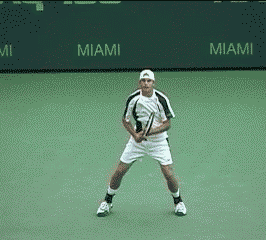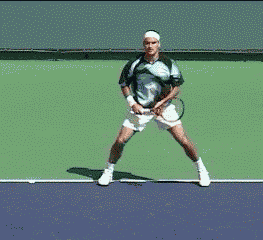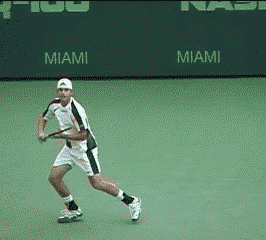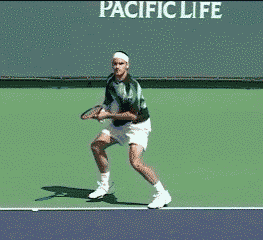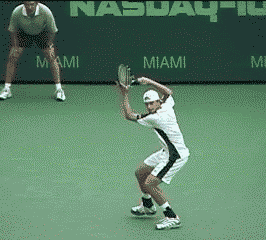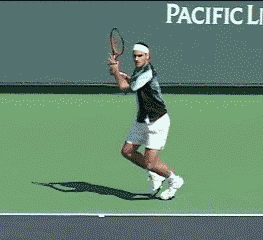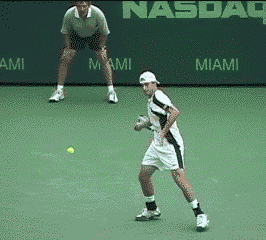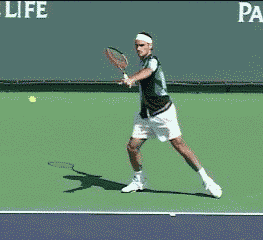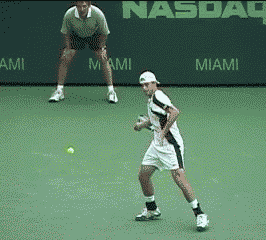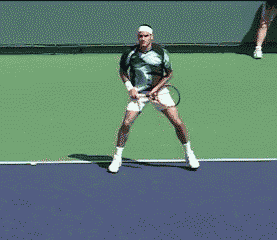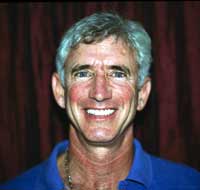|
TennisOne Lessons
Can Andy Roddick Regain his Mojo? Jack Broudy Once upon a time Andy Roddick was a force to be reckoned with. Backed by a big forehand and an even bigger serve, Roddick reached the number one spot on the ATP tour in 2002, garnering the US Open title along the way. At that time, his name resonated with the likes of Andre Agassi and Pete Sampras and his future seemed assured. But that was then and now . . . well now, Roger Federer is the anointed one and Roddick, that former formidable #1, has slowly evolved into a streaky journeyman with a big serve and very little balance to his game. Several years and a couple of coaches later, he seems to be ever so slowly slipping down the ladder. Although his ranking hasn’t exactly plummeted, he seems to possess little of the ‘mojo’ he once had going for him.
All of a sudden It seems everyone on tour has a shot at Andy. How could this have happened? Perhaps it can be traced to specific strategies or stroke preferences Andy has developed over the last few years. The continuing idea of developing a big serve or forehand as a “weapon” (or any one weapon for that matter) causes players to design their game to accommodate such weapons. Players like Roddick have been seen to run around backhands, hit swinging volleys, or simply avoid the net entirely. (Although, Roddick has made a cursory stab at trying to gain an ‘all court’ game.) While there have been exceptions, (Sampras, Agassi, Lendl and Edberg to name a few), generally, we’re coming off a generation of “one hit wonders” just looking for their “big shot” while trying to hide their weaknesses. Unfortunately for Roddick, (and perhaps many of today’s juniors), the game has moved past the strategies of these one-shot wonders. To be effective, today’s players need to exhibit strengths on both wings as well as more affinity for net play A player like Jim Courier, a great champion to be sure, would have a difficult time today with just a big inside-out forehand. And like Courier, Roddick is now experiencing problems relying mainly on his serve to get him through. In fact, he is often out-aced in many matches by players who have less average serve-speed but better overall effect. In addition, his once very potent forehand is outclassed by many of today’s top players. I believe there is a type of “perfection” inherent in all the strokes in tennis and Roger Federer alone seems to be on a personal quest to find and establish this perfection in his game. One of the major keys to his game is that Federer “lines up” perfectly to the ball, at the 45º angle to the net, and stays aligned with it throughout the stroke. I think this alone is one of the major reasons his game has become almost unbeatable. Let’s take a systematic look at Andy Roddick's game starting with his forehand and compare it to Roger Federer's forehand. A stroke comparison According to the tennis World, Andy’s forehand is his best shot besides his serve, (which, by the way, I believe is a well produced stroke.) He can hit some big forehands, and occasionally slap a winner, but lately he’s been hitting short, brushing over the ball too much, and not getting the kind of “pop” he needs. He also seems to be missing more and there's not enough disguise on his stroke to fool anyone.
Let’s take a look at the Roddick and Federer forehands side by side, to get a better idea of what I’m seeing, and how Andy (and you reading along) can balance out that forehand. Above, I chose an open stance forehand to examine, however, it really doesn’t matter what forehand I chose to look at because the differences in the two players “operating systems” are apparent on just about every shot. In the beginning of the stroke Andy is pulling up with his elbow and shoulder as he “loads up” for the shot. (By the way, “loading up” is necessarily a bad thing, no matter what the tennis commentators might otherwise have you believe. “Loading up” for most players usually ends up being too extreme and off balanced in the backswing, thus losing the “effortless hit”.) You can see the stretch in his left leg showing how his hips are lagging behind his shoulders and arm. Andy is quickly into his arms and upper body, and way too extreme in his backswing. “The tail is wagging the dog.” The hips should initiate the stroke while the rest of the body stays relaxed and lined up to the hit, at the 45º. Roger, on the otherhand, begins effortlessly and naturally. His hands are relaxed at his side and the only thing moving are his hips as they orient the stroke to the 45º angle to the net.
Next, notice where the two players let go of the racquet head with their non-hitting hand. Andy keeps his left hand on the racquet way past his hitting point, starting his stroke off-balanced and top heavy. His hands put all of his weight on the backside of the 45º line (which ideally should be his contact point). He’s completely sideways to the net and will likely be early or late at contact! He needs to keep both sides of his body in balance on the hit! Like drawing a bow and arrow, the hand holding the bow stays steady, out in front, to zero in on the target. On the contrary, Roger sets up with both hands at the 45º to the net, lining up to the hit, and then, as his hips continue the turn into the backswing, his left hand immediately breaks off and extends out in front of the 45º line, setting his balance on the hit. Notice how, with Roger, everything is compact, keeping the stroke and power contained and the shot selection well disguised. Once again, Andy’s arms and shoulders are initiating the movement in the body (hips trailing) — tail wagging the dog!
As they “transition” from backswing to foreswing, notice how Andy has already, not only committed to where he’s going to hit the ball, so it becomes readily apparent to his opponent, but he has pulled his body away from the hit. He’s completely off-balance with another extreme movement of the shoulders. Roger's hip rotation is apparent but he still manages to keep his upper body still at the 45º (or at the hit). His core is quiet and therefore he can stay relaxed throughout the stroke. Because Andy’s legs have already straightened, he cannot engage his hips without first pulling his shoulders. So not only will Andy be facing the net when he makes contact, telegraphing his shot, but he’s not really getting any weight into the hit because he’s pulling away from the 45º, and hence the shot becomes more of a slap with the wrist and elbow.
The story now unfolds at contact. Roger hits with the pure definition of centrifugal force, balance and razor-sharp precision, while Andy is busy trying to muscle the ball into a general area of the court. You can readily see the difference in balance of a player who keeps his alignment on the 45º angle throughout the stroke and one who does not. While Roger’s hitting arm extends out and lengthens into the hit, his right (back) leg extends out behind him at the exact opposite angle lining him up perfectly to the hit (at the 45º.) Andy actually contracts his arm, bending his elbow as he makes contact. Who do you think will get more leverage on this shot? And more leverage means you can do less, and doing less means it’s easier to control and more efficient.
Finally, notice how Andy makes contact while his body and racquet face are directly open and facing the net, meaning he will make contact with the back of the ball. This contact produces more of a slap as opposed to a feeling of “grabbing the ball. Because Roger is lined up at the 45º during contact, his racquet face is in line with the 45º angle, and therefore he gets a nicer grab on the ball giving him a cleaner hit and more precision. Also, take a look at the two player’s heads: Roger’s remains relatively stable during the entire stroke, while Andy’s is moving all over the place, especially at contact. He’s looking straight towards the net. The follow through is really incidental, because it’s impossible for Andy to follow through properly since he’s already pulled off the ball before and during the hit. It once again shows the imbalance and extreme nature of Andy’s stroke, versus the quietude and control of Roger's.
Roddick overextends, and by trying to do more, misses shots because he goes out of control. Look how, from beginning to end, Roger stays focused on the 45º angle, and exudes a calm stillness. Andy is falling away from the contact point and relying on his arm to control the hit. Opening up too early makes it nearly impossible for Andy to have a real follow through. But because Roger stays on the 45º angle with his body and head, it is quite easy for his arm to completely come through the stroke. He resembles a spinning top, whereas Andy looks like he’s having difficulty maintaining balance. His head starts facing the net, turns to the side, then back to the net. There is a qualitative difference between the two players at every point in the stroke, that is easy to see. By moving symmetrically to the ball Roger never overtaxes his body. He hits well and recovers quickly. Roger appears faster than Andy primarily because he never has to regain his center. He’s always in balance. The efficiency in forehands of players like Federer and Agassi is the reason they can play closer to the baseline. Roddick’s stroke is so extreme in both directions and so unbalanced, that he has to stand behind the baseline to give himself more time. Of course this gives him a longer distance to run on angles and consequently he has less time. What he needs to do is improve the stroke. Next time, I will examine the much criticized Roddick Backhand. Your comments are welcome. Let us know what you think about Jack Broudy's article by emailing us here at TennisONE 8Board Tennis SystemIf any of my articles regarding the nonlinear game and the 8Board® Tennis System strike a chord in you, or you’d like to learn more, please send along your comments and visit 8boardtennis.com. If you’re also a golfer please visit 8boardgolf.com.
|

